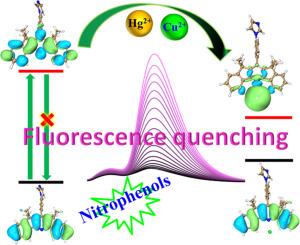基于三官能团配体的新型三维发光Pb-CP传感重金属离子和硝基酚
IF 4.7
2区 化学
Q2 CHEMISTRY, PHYSICAL
引用次数: 0
摘要
通过合理设计,采用多组分反应合成了新型三官能配体H4L (3,3 ',3 ',3 ''-(11-(4-(1h -咪唑-1-基)苯基)-10,12-二氢二茚[1,2-b:2 ', 1 ']吡啶10,10,12,12-四基)四丙酸。此外,合成了一种以H4L为配体的新型发光铅基配位聚合物(CP-Pb),并用单晶x射线衍射对其结构进行了表征。CP-Pb中的两个Pb原子被桥接到两个COO-基团上,形成双核簇。此外,CP-Pb显示出一个由5连接节点连接的三维结构,可以简化为一个sqc拓扑的(4,6)连接网络。此外,CP-Pb对Hg2+和Cu2+的检测灵敏度较好,Hg2+和Cu2+的检出限分别为0.54 μM和0.63 μM。通过实验和密度泛函理论,系统地研究了可能的荧光猝灭机理。Hg2+/Cu2+离子与不配位吡啶基之间的强相互作用在很大程度上促进了分子间电子转移过程,从而导致荧光猝灭。而对硝基苯酚的传感机制则归因于荧光共振能量转移(FRET)、竞争吸收(CA)、光致电子转移(PET)以及CP-Pb与硝基苯酚之间强的N·h·o氢键相互作用的共存。本文章由计算机程序翻译,如有差异,请以英文原文为准。

A novel 3D luminescent Pb-CP based on a trifunctional group ligand for sensing heavy metal ions and nitrophenols
A novel trifunctional ligand H4L (3,3′,3′',3′''-(11-(4-(1H-imidazol-1-yl)phenyl)-10,12-dihydrodiindeno[1,2-b:2′,1′e]pyridine 10,10,12,12-tetrayl)tetrapropionic acid) was synthesized through rational design using a multicomponent reaction. In addition, a new luminescent lead-based coordination polymer (CP-Pb) based on the ligand H4L was synthesized and its structure was characterized by single-crystal X-ray diffraction. Two Pb atoms in CP-Pb are bridged to two COO- groups to form a binuclear cluster. In addition, CP-Pb displays a 3D structure connected by 5-connected node, which can be simplified into a (4,6)-connected network with sqc topology. Furthermore, CP-Pb exhibit satisfactory sensitivity for the detection of Hg2+ and Cu2+ with low detection limits of 0.54 μM for Hg2+ and 0.63 μM for Cu2+, respectively. The possible fluorescence quenching mechanisms were systematically investigated through experiments and density functional theory. The strong interactions between Hg2+/Cu2+ ions and the uncoordinated pyridyl groups largely promote the intermolecular electron transfer process, thereby causing fluorescence quenching. While the sensing mechanism for nitrophenols was attributed to the co-existance of fluorescence resonance energy transfer (FRET), competitive absorption (CA), photo-induced electron transfer (PET) and the strong N‧‧‧H-O hydrogen bonding interactions between the CP-Pb and nitrophenols.
求助全文
通过发布文献求助,成功后即可免费获取论文全文。
去求助
来源期刊

Journal of Molecular Structure
化学-物理化学
CiteScore
7.10
自引率
15.80%
发文量
2384
审稿时长
45 days
期刊介绍:
The Journal of Molecular Structure is dedicated to the publication of full-length articles and review papers, providing important new structural information on all types of chemical species including:
• Stable and unstable molecules in all types of environments (vapour, molecular beam, liquid, solution, liquid crystal, solid state, matrix-isolated, surface-absorbed etc.)
• Chemical intermediates
• Molecules in excited states
• Biological molecules
• Polymers.
The methods used may include any combination of spectroscopic and non-spectroscopic techniques, for example:
• Infrared spectroscopy (mid, far, near)
• Raman spectroscopy and non-linear Raman methods (CARS, etc.)
• Electronic absorption spectroscopy
• Optical rotatory dispersion and circular dichroism
• Fluorescence and phosphorescence techniques
• Electron spectroscopies (PES, XPS), EXAFS, etc.
• Microwave spectroscopy
• Electron diffraction
• NMR and ESR spectroscopies
• Mössbauer spectroscopy
• X-ray crystallography
• Charge Density Analyses
• Computational Studies (supplementing experimental methods)
We encourage publications combining theoretical and experimental approaches. The structural insights gained by the studies should be correlated with the properties, activity and/ or reactivity of the molecule under investigation and the relevance of this molecule and its implications should be discussed.
 求助内容:
求助内容: 应助结果提醒方式:
应助结果提醒方式:


